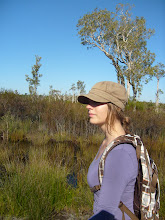Natural animal behaviour is notoriously hard to pin down, as many frustrated biologists have experienced in the field. Including me. Why? You’d think you only have to find the animal you want to watch and then keep your eyes peeled. Well, it’s because us biologists have an obsession with natural behaviour, the stuff animals do when they are completely among themselves.
And there you have the problem, by simply being present you’re disturbing the natural environment of those animals and as an effect also their behaviour. Once you’re physically present, you can never be sure whether you are observing natural, normal behaviour anymore. When that certain baboon keeps staring at you, you can be reasonably sure it is not. Even when you let the animals get habituated to your presence, it is never said they go completely back to their former routine. When observing an animal like, for example, an earthworm, something that is not particularly sensitive to your presence, you’ll interfere with ground vibrations when you move, attack risk by birds etc etc.
So what do you do?
With the evolution of digital cameras we are getting a step closer to taking a more hands-off approach. We can take ourselves out of the picture and put in a (disguised) camera that photographs or films the animals for us. Camera traps are an old and well-established method of capturing elusive mammals like the black panther in the Amazon.
We’re sacrificing a lot by using cameras instead of our own eyes howe. For example, a camera doesn’t have neck muscles that can move its lens freely up or down, left or right. You just hope it captures the animal when it is ‘behaving’.

Maybe some of you remember the BBC documentary from 2000 ‘Lions – Spy in the den’. David Attenborough takes people on a journey into a lion’s den with the help of ‘boulder cam’. A motorised camera with microphones all disguised as a rock. It provided a new, fascinating insight in lion behaviour.
Lion cubs are curiously investigating the boulder
cam when it appeared near their den
For an introduction to Lions – Spy in the den, check:http://www.jdp.co.uk/programmes/Lions-Spy-in-the-Den&f=boudlercam1.flv&n=The%20Cubs%20Meet%20Bouldercam
Are robots the future?
Reasonably new technology, known as bionic engineering, has the potential to take this idea even a step further. Now widely used for robotic arms and other handling technology, a German company has experimented in recent years with animal shapes and forms. What they came up with is truly inspiring.
The goal behind this technology is to learn from nature. The overall idea resides in that nature, in billions of years of natural selection, has done the trial and error process for us. It has provided us with the most adapted, most varied and most effective shapes and designs possible. So why not learn from it? While building these animal robots, the designers have found many ways to implement the natural structures into elegant, functional engineering feats.
But that is not particularly why I feel inspired about it. These robots are on a level of perfection that makes them ideal spies. Infiltrating the natural environment as one of their own, manoeuvrable and indistinguishable. It is not like the boulder cam, getting close, but still an outside observant. It could take us truly inside animal populations and observe their true colours. To me, that is an exciting prospect!


Hey Eveline, Love your blog :-) I'm a student who's considering doing her MSc in Conservation biology at DICE as well and i was wondering if you could help me to answer a few questions about the course. Do get in touch with me at natasha.sah at g m a i l dot come
ReplyDelete